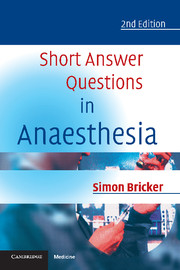Book contents
- Frontmatter
- Contents
- Preface
- Preface to the 1st edition
- Abbreviations
- 1 Advice on answering short answer questions
- 2 General Anaesthesia
- 3 Anaesthesia and Medical Disease
- 4 Medicine and Intensive Care
- 5 Obstetric Anaesthesia and Analgesia
- 6 Paediatric Anaesthesia
- 7 Neuroanaesthesia
- 8 Acute and Chronic Pain
- 9 Trauma and Emergency Anaesthesia
- 10 Anatomy, Applied Anatomy and Regional Anaesthesia
- 11 Pharmacology and Applied Pharmacology
- 12 Clinical Measurement and Equipment
- 13 Cardiac and Thoracic Anaesthesia
- Index
10 - Anatomy, Applied Anatomy and Regional Anaesthesia
Published online by Cambridge University Press: 05 February 2014
- Frontmatter
- Contents
- Preface
- Preface to the 1st edition
- Abbreviations
- 1 Advice on answering short answer questions
- 2 General Anaesthesia
- 3 Anaesthesia and Medical Disease
- 4 Medicine and Intensive Care
- 5 Obstetric Anaesthesia and Analgesia
- 6 Paediatric Anaesthesia
- 7 Neuroanaesthesia
- 8 Acute and Chronic Pain
- 9 Trauma and Emergency Anaesthesia
- 10 Anatomy, Applied Anatomy and Regional Anaesthesia
- 11 Pharmacology and Applied Pharmacology
- 12 Clinical Measurement and Equipment
- 13 Cardiac and Thoracic Anaesthesia
- Index
Summary
Describe the anatomy of the coeliac plexus. What are the indications for its therapeutic blockade?
This question comes as a surprise for many candidates, but the anatomy of the area is important and coeliac plexus block is very effective for malignant pain.
Introduction
The coeliac plexus is most commonly the target for anaesthetists who are treating malignant visceral pain. The anatomy may be described as follows:
The coeliac plexus is the largest sympathetic plexus and lies anterior to the abdominal aorta where as a dense network of nerve fibres it surrounds the root of the coeliac artery at the level of L1 .
There are two ganglia, right and left, which are closely related to the crura of the diaphragm.
The plexus receives the greater splanchnic nerve (fibres from T5 to T9 or 10) and the lesser splanchnic nerve (fibres from T9/10 or T10/11).
The plexus also receives some filaments from both the vagus and the phrenic nerves bilaterally.
Superiorly lie the crura of the diaphragm; posteriorly is the abdominal aorta; laterally are the adrenal glands in the superior poles of left and right kidneys; the important anterior relation is the pancreas.
Therapeutic block. The plexus can be blocked in conjunction with intercostal nerves in order to provide analgesia for intra-abdominal surgery. This technique does not have many enthusiasts. More commonly it is used for the relief of malignant pain, typically that due to carcinoma of the pancreas. Neurolytic blocks give good analgesia in up to 90% of patients, although the effect may only last for a number of months.
[…]
- Type
- Chapter
- Information
- Short Answer Questions in Anaesthesia , pp. 247 - 272Publisher: Cambridge University PressPrint publication year: 2002



